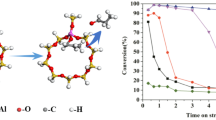Abstract
Investigation of the reaction mechanism of chloromethane on ZSM5 is a new topic. In this work an in situ FTIR technique was employed to study the conversion processes of chloromethane, the active sites on HZSM5, and the desorption state of surface species. The catalytic conversion of chloromethane to higher hydrocarbons was also studied. It is demonstrated that chloromethane can be reversibly adsorbed on acidic sites of HZSM5 at room temperature. At 100°C chloromethane is irreversibly and dissociatively adsorbed on the strong acidic sites of HZSM5, on which surface methoxyl is formed as proved by infrared characteristic C-H stretchings of-CH3 at 2960 and 2870 cm−1. Alkoxyls are produced and adsorbed on the catalyst surface as characterized by the infrared absorption bands of -CH2-groups at 1460 and 2930 cm−1. At 100°C the adsorbed methoxyl and alkoxyls are the main surface species, and a small amount of aromatics might exist as detected by a characteristic absorption band at 1510 cm−1. Between 100 and 200°C the adsorbed surface methoxyl and alkoxyls are converted to aromatics, and the occupied OH groups partially appear. At temperature higher than 300°C the adsorbed aromatics are thermally desorbed into the gas phase. Aromatics and alkanes are the main products in catalytic conversion. These results reveal that the formation of aromatics from methoxyl and alkoxyls is easier than the desorption of aromatics from HZSM5 catalyst. An alkoxyl mechanism is proposed for the conversion of chloromethane on HZSM5 based upon the experimental results and the three assumptions: (a) The primary C-C bond is formed from surface methoxyl groups via the methoxyl group polarization and C-H bond weakening, (b) The adsorbed alkoxyls are converted to aromatics via hydrogen transfer and bond rearrangement similar to the conventional carbenium ion mechanism for the aromatization of olefins and alkanes on HZSM5. The hydrogen atoms from the aromatization stimulate the desorption of alkoxyls to alkanes. (c) At temperature higher than 300°C surface reactions and desorption of adsorbed species take place simultaneously, determining the product distribution in the catalytic conversion.
Similar content being viewed by others
References
J.R. Anderson, Appl. Catal. 47 (1989) 177.
J.S. Lee and S.T. Oyama, Catal. Rev. Sci. Eng. 30 (1988) 249.
X.R. Xia, G.X. Xiong, Y.L. Bi, K.J. Zhen and X.X. Guo, J. Nat. Gas Chem., in press.
V.P. Tretyakov and A.N. Osetskii, Kinet. Katal. 23 (1983) 958.
C.E. Taylor and R.P. Noceti, in:Proc. 9th Int. Congr. on Catalysis, Vol. 2, eds. M.J. Phillips and M. Ternan (Chem. Inst. of Canada, Ottawa, 1988) p. 990.
V.N. Romannikov and K.G. Ione, Kinet. Katal. 23 (1983) 958.
S.A. Butter, A.T. Jurewicz and W.W. Kaeding, US Patent 2 394 107 (1975).
C.D. Chang, Catal. Rev. Sci. Eng. 25 (1983) 1.
P.B. Venuto and P.S.L. Landis, Adv. Catal. 18 (1968) 259.
F.A. Swabb and B.C. Gates, Ind. Eng. Chem. Fundam. 11 (1972) 540.
Y. Ono and T. Mori, J. Chem. Soc. Faraday Trans. I 77 (1981) 2209.
J.P. van den Berg, J.P. Wolthuizen and J.H.C. van Hoff,Proc. 5th Conf. Zeolites, Naples 1980, p. 648.
R.H. Nobes, W.R. Rodwell, W.J. Bouma and L. Radom, J. Am. Chem. Soc. 103 (1981) 1913.
W.G. Guo, J. Liang, S.Q. Zhao and R.H. Wang, Cuihua Xuebao 5 (1984) 11.
J.C. Vedrine, A. Auroux, V. Bolis, P. Pejaifve, C. Naccache, P. Wierzchowski, E.G. Derouane, J.B. Nagy, J.-P. Gilson, J.H.C. van Hoff, J.P. van den Berg and J. Wolthuizen, J. Catal. 59 (1979) 248.
Q.N. Dong, Cuihua Xuebao 7 (1986) 22.
X.R. Xia, The mechanism of monosubstituted methane on HZSM5, in preparation.
H. Pines,The Chemistry of Catalytic Hydrocarbon Conversion (Academic Press, New York, 1981).
X.H. Guo, X.X. Long, S.X. Xiao and T.L. Chen, Cuihua Xuebao 9 (1988) 396.
J. Novakova, L. Kubelkova and Z. Dolejsek J. Catal. 97 (1986) 277.
J. Novakova, L. Kubelkova and Z. Dolejsek, J. Mol. Catal. 45 (1988) 365.
G. Mirth and J. A. Lercher, J. Catal. 132 (1991) 244.
L.H. Little,Infrared Spectra of Adsorbed Species (Academic Press, London, 1966) p. 1.
B.J. Ahn, J. Armando, G. Perot and M. Guisnet, Compt. Rend. Acad. Sci. C 288 (1979) 245.
K.G. Inoe, V.G. Stepanov and S.E. Shepelev, Khim. Tverd. Topl. 16 (1982) 35.
Author information
Authors and Affiliations
Rights and permissions
About this article
Cite this article
Xia, XR., Bi, YL., Wu, TH. et al. An infrared spectroscopic study of the mechanism of chloromethane conversion to higher hydrocarbons on HZSM5 catalyst. Catal Lett 33, 75–90 (1995). https://doi.org/10.1007/BF00817048
Received:
Accepted:
Issue Date:
DOI: https://doi.org/10.1007/BF00817048




